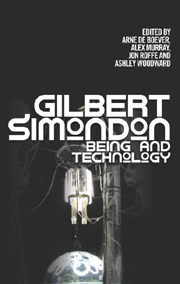Book contents
- Frontmatter
- Contents
- Abbreviations
- Editors' Introduction: Simondon, Finally
- 1 Technical Mentality
- Explications
- Implications
- 5 The Question of Anxiety in Gilbert Simondon
- 6 Infra-Psychic Individualization: Transductive Connections and the Genesis of Living Techniques
- 7 ‘Du mort qui saisit le vif’: Simondonian Ontology Today
- 8 The Aesthetics of Gilbert Simondon: Anticipation of the Contemporary Aesthetic Experience
- Resonances
- Glossary: Fifty Key Terms in the Works of Gilbert Simondon
- Notes on Contributors
- Index
7 - ‘Du mort qui saisit le vif’: Simondonian Ontology Today
from Implications
Published online by Cambridge University Press: 12 September 2012
- Frontmatter
- Contents
- Abbreviations
- Editors' Introduction: Simondon, Finally
- 1 Technical Mentality
- Explications
- Implications
- 5 The Question of Anxiety in Gilbert Simondon
- 6 Infra-Psychic Individualization: Transductive Connections and the Genesis of Living Techniques
- 7 ‘Du mort qui saisit le vif’: Simondonian Ontology Today
- 8 The Aesthetics of Gilbert Simondon: Anticipation of the Contemporary Aesthetic Experience
- Resonances
- Glossary: Fifty Key Terms in the Works of Gilbert Simondon
- Notes on Contributors
- Index
Summary
INTRODUCTION: THE CHEMICAL, THE APOPTOTIC AND THE ARTEFACT; OR, THE HYPOTHESIS OF THREE TYPES OF ‘NON-LIFE’ THAT CONDITION LIFE AS EVOLUTION
As the title of this Introduction indicates, I will not ask myself about the as-it-were metaphysical distinction between the dead [‘le’ mort] and death [‘la’ mort]. What interests me is more generally the presence of ‘non-life’ in life, and as the very condition of life. I would like to suggest that different stages of life qua evolution correspond to different types of essential non-life. The ‘non-living’ can certainly designate the artefact, but it first of all signifies inert naturalness [naturel], therefore the physical. Simondon sees in the physical and the ‘vital’, as he says, two ‘regimes of individuation’. But in choosing to treat of ‘le mort qui saisit le vif’, I propose in fact, as will appear, to cover the whole genetic ontology of Individuation in the Light of Notions of Form and Information in so far as it derives from the living the third regime of individuation itself, called by Simondon the ‘transindividual’. But the red thread of this traversal of genetic ontology is in another way what, to my mind, allows us at the same time to unify and exceed it, because this red thread is what I have elsewhere called the ‘auto-transcendent sense’ of the Simondonian genetic ontology. Such are the stakes of my account, because the exegesis of the Simondonian œuvre from which my first two works emerged would already be polemical in its very fidelity, and concerned by this to locate in Simondon what might give him all his contemporaneity.
- Type
- Chapter
- Information
- Gilbert SimondonBeing and Technology, pp. 110 - 120Publisher: Edinburgh University PressPrint publication year: 2012



